Mouth ulcers are painful areas in the mouth and gums. They range in size, and the exact symptoms of a mouth ulcer will depend on the type.
While mostly harmless, mouth ulcers can be extremely uncomfortable and make it difficult for some people to eat, drink, and brush their teeth.
Fast facts on mouth ulcers:
- Most mouth ulcers are recurring nuisances that are benign.
- Smoking and acidic foods can aggravate mouth ulcers.
- It is important to note that a doctor or dentist should examine any new ulcer and any ulcer lasting longer than 3 weeks.
- For most people, mouth ulcers will clear up within 2 weeks.

A mouth ulcer is a small, painful lesion that forms inside the mouth. They can appear as round or oval sores with a white, yellow, or gray center and a red border.
In general, mouth ulcers are benign and harmless, although they can cause discomfort. Standard ulcers appear on the inner cheeks and last for about
It is best to consult a doctor if mouth ulcers:
- keep recurring
- last longer than 3 weeks
- seem different from previous mouth ulcers, for example, they are bigger or near the back of the throat
- bleed or become more painful and red, as this may indicate infection
- interfere with how much a person can eat or drink
Are mouth ulcers cancerous?
Mouth cancer and mouth ulcers have distinctive symptoms. However, it is best to seek medical advice for new, persistent, or generally concerning ulcers.
There are some fundamental differences between mouth ulcers and what might be cancer:
- Mouth ulcers are often painful, whereas mouth cancer is not.
- Mouth ulcers will clear up in about 1-2 weeks, whereas mouth cancer will not go away and will often spread.
- Mouth cancer is often a mix of red and white areas or large white areas that appear on the tongue, the back of the mouth, gums, or cheeks.
- Mouth cancer often links to heavy drinking or tobacco use.
Learn about what mouth cancer looks like here.
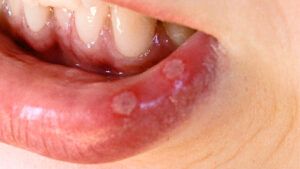
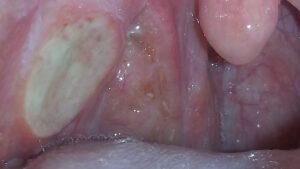
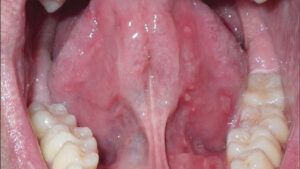
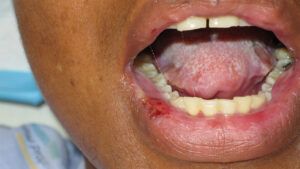
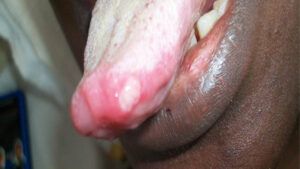
The most common type of mouth ulcer is aphthous ulcer, also known as a canker sore. They often have no specific cause.
There are three subtypes of these mouth ulcers. These are:
- Minor ulcers: These ulcers are small, measuring around
5 millimeters (mm)Trusted Source and under, and typically heal on their own within 1–2 weeks. They are the most common type of ulcer. - Major ulcers: These are larger, deeper sores that can measure 10mm or more and may last for 5 to 10 weeks. They often leave scars but are less common than minor ulcers.
- Herpetiform ulcers (HU): These appear as a cluster of small ulcers that can merge into larger lesions. They get their name because they resemble the sores associated with herpes, but they have no connection to the herpes virus and are not contagious. They are the least common type of ulcer and also typically heal within 1-2 weeks.
There are many other types of mouth sores or lesions. Some can result from injuries, infections, or systemic conditions. These include:
- Oral lichen planus: Lichen planus is an immune-related condition that causes itchy rashes and white sores inside the mouth.
- Leukoplakia: Leukoplakia are thickened white or gray patches in the mouth, resulting from excess cell growth.
- Erythroplakia: Red patches that can develop under the tongue or behind the lower front teeth due to smoking.
- Oral thrush: Oral thrush is a fungal infection caused by an overgrowth of the yeast Candida albicans. It can occur due to a weakened immune system, diabetes, antibiotics, or certain medications.
- Mouth cancer: Mouth cancer may cause persistent red or white sores or ulcers in the mouth that fail to heal naturally.
General symptoms of a mouth ulcer
The ulcer may be round or oval in shape, with a white, yellow, or gray center and a red, inflamed border.
A singular ulcer measuring less than 5mm is likely a minor ulcer. A larger sore of 10mm or above indicates a major ulcer and a cluster of tiny ulcers may be HU.
Other symptoms that may accompany a mouth ulcer include:
- mild swelling or redness around the affected area
- a burning or tingling sensation in the area
beforeTrusted Source the sore appears - pain or irritation from certain foods,
especiallyTrusted Source spicy or acidic foods - bleeding from the ulcer if it becomes irritated
Experts do not fully understand why aphthous ulcers occur. However, some things may trigger a mouth ulcer, including:
- injury, such as biting the inner cheek or irritation from braces or dentures
- stress
- smoking
- deficiencies in folic acid, iron, or vitamin B12
- a weakened immune system
- chemotherapy
Aphthous ulcers can be a symptom of systemic conditions, such as:
To relieve the pain of a mouth ulcer and speed up recovery, a person can try the following over-the-counter (OTC) treatments and home remedies:
- Topical gels and ointments: Many pharmacies sell OTC gels for mouth ulcers that contain benzocaine, lidocaine, or hydrocortisone to numb the pain and reduce inflammation.
- Mouthwashes: Antiseptic or anti-inflammatory mouthwashes can prevent infection and promote healing. Options include those containing chlorhexidine or hydrogen peroxide.
- Pain relievers: Taking acetaminophen or nonsteroidal anti-inflammatory drugs (NSAIDs) like ibuprofen can relieve discomfort.
- Saltwater rinse: Saltwater has antibacterial properties and can help reduce swelling and keep the area clean. To do this, a person can dissolve 1 teaspoon of sea salt in warm water and rinse the mouth for 30 seconds
- Coconut oil: Coconut oil has antimicrobial properties and may help prevent infection. A person can try oil pulling with coconut oil by taking a spoonful and keeping it in the mouth for a few minutes. Once done, it is best to spit the oil into a bin, as it can harden and block the sink. A person should not swallow the oil and should rinse the mouth with water afterward to get rid of any oil residue.
In severe cases, a doctor may prescribe medications to ease the pain of a mouth ulcer or address the causes.
Prescription corticosteroid gels or tablets like triamcinolone may reduce severe inflammation. In rare cases, a doctor may prescribe medications like colchicine or immunosuppressants.
Preventing mouth ulcers involves minimizing potential triggers, maintaining good oral hygiene, and addressing any underlying health issues.
Though the appearance of an ulcer may be inevitable, there are some things people can do to lessen the severity of or reduce the number of times they suffer from an outbreak.
Some prevention methods include:
- talking to a doctor about changing medications that are known to cause ulcers
- avoiding foods that can either trigger or worsen symptoms
- keeping the mouth clean with daily brushing and flossing
- avoiding triggers known to cause outbreaks in the past
Mouth ulcers, also known as canker sores, are small, painful sores that develop inside the mouth. They often appear as round or oval lesions with a white or yellow center and a red border.
While the exact cause is unknown, triggers can include stress, minor injuries, nutritional deficiencies, hormonal changes, or certain medical conditions like celiac disease or Crohn’s disease.
Most mouth ulcers are harmless and heal on their own within 1–2 weeks, but larger or recurrent sores may require medical attention.
Treatments include over-the-counter gels, antiseptic mouthwashes, and home remedies like saltwater rinses or honey.
Preventive measures include maintaining good oral hygiene, avoiding irritants like spicy foods, and addressing underlying health issues.


